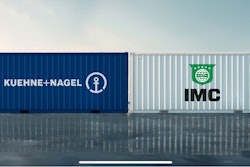At the end of 2022, CCJ's reporting on large carrier earnings indicated that the pandemic party might have come crashing to an end. In Q1 of 2023, perhaps the hangover began as carriers begin to report revenues flat or just slightly up, and profits absolutely falling through the floor – sometimes more than 70%. Carriers alternately blame inflation, insurance settlements and all around market softness for the declines. Only Heartland Express, which recently acquired CFI, posted a year-over-year beat on profit, and that was only by a slim margin.
See the gory details in the write ups below.
Covenant's slimmed down fleet turns a profit
Covenant (CCJ Top 250, No. 38) saw revenue dip since last quarter, but an uptick in profitability as it navigated a tough freight market in Q1. Total revenue in combined truckload operations dropped 3.5%, led by a $7 million drop in revenue from its dedicated segment, wherein it shed 194 tractors. "The decrease in tractors was attributable to the exit of underperforming business," Paul Bunn, the Company’s President and Chief Operating Officer said. Last quarter, the company reported a $10 million hit from early lease abandonment and disposal charges on a glut of older equipment.
“The first quarter’s freight market, consisting of a combination of freight rates and volumes, has materially softened compared to a year ago and has remained soft throughout April," he continued. "Our asset-light segments, consisting of Managed Freight and Warehousing, experienced significant deterioration in margin compared to the prior year quarter as a result of reductions in brokerage volumes and rates associated with overflow freight from our asset-based segments."
Revenue: 2023 Q1: $266.8 million vs. 2022 Q1: $291.6 million
Income: 2023 Q1: $17.6 million vs. 2022 Q1: $23.8 million
–
Forward Air Corporation predicts rough seas ahead
Forward Air Corporation (No. 50) saw revenue and income decline sharply from last year and last quarter, and forecasts an even bigger decline in Q2 of 2023.
The company did beat its projected net income per diluted share, but that was thanks to a "one-time benefit ... from the substantial reversal of an accrual for an incentive plan established for employees in 2021. The reversal was driven by the headwinds we continue to experience from the weaker-than-expected freight environment," Tom Schmitt, President and CEO of the company said.
Regarding the Company’s second quarter 2023 guidance, Rebecca J. Garbrick, CFO, said, “We expect our year-over-year revenue to decline 7% to 17%."
Revenue: 2023 Q1: $427.1 million vs. 2022 Q1: $466.9 million
Income: 2023 Q1: $50.5 million vs. 2022 Q1: $57.4 million
–
Double trouble at Heartland Express?
Heartland Express (No. 42) found a way to double revenue despite a freight recession: doubling the size of its fleet. Since acquiring CFI in August of 2022, Heartland has paid down its debts from $447 million to $366 million. But despite a 118% jump in revenues due to larger fleet size, profits only went up 2.2% since last quarter.
"We are attempting to improve the financial results of two large organizations during a period where freight demand is significantly less than it has been in the last two years along with significant pressure from many shippers to reduce freight rates while operational costs continue to rise," CEO Mike Gerdin said.
"Freight demand in the first quarter is typically softer due to expected seasonality following the fourth quarter holiday season, but the current demand levels are much lower than the standard and expected seasonality changes. Given what we have experienced and based on feedback from our customers, we expect volatile freight demand for at least the next two quarters of 2023," he continued.
Revenue: 2023 Q1: $330.9 million vs. 2022 Q1 $151.3 million
Income: 2023 Q1: $22.9 million vs. 2022 Q1: $22.4 million
–
J.B. Hunt sees 'atypical' headwinds in Q4
J.B. Hunt (No. 3) saw revenue drop 7%, mostly due to a full 25% drop in Integrated Capacity Solutions and a 5% drop in Intermodal. Additionally, total freight transactions in the Marketplace for J.B. Hunt 360 dropped 38%, from $600 million to $370. One bright spot was the Dedicated Contract Services segment, which saw revenue jump 13% and profits up 29%, thanks to.moving 398 more trucks into the segment.
Revenue: 2023 Q1: $3.23 billion vs. 2022 Q1: $3.49 billion
Income: 2023 Q1: $277.5 million vs. 2022 Q1: $334.3 million
–
Knight-Swift Transportation sees freight volumes, profits slashed
Knight-Swift (No. 4) saw a 10.4% decrease in revenue over last year and a 51.4% drop in operating income, hobbled by decreased load counts in its Truckload and Logistics segments, as well as a "negative development on certain large prior year insurance claims totaling $8.5 million."
The company's acquisition of U.S. Xpress, one of the biggest in the space, was announced March 21 and has yet to impact operations.
"The general lack of import activity, especially on the West Coast, negatively impacted freight volumes and led to a more competitive bid season. The absence of the typical seasonal uplift in March saw truckload spot rates drift lower to levels that we believe are below cash operating costs for a large portion of carriers, especially smaller and less-well-capitalized operators," David Jackson, the CEO said.
Revenue: 2023 Q1: $1.64 billion vs. 2022 Q1: $1.83 billion
Income: 2023 Q1: $144.8 million vs. 2022 Q1: $298.1 million
–
Landstar sees a bright spot in flatbed
Landstar (No. 9) saw revenue drop more than a quarter and income fully dropping more than 50%. The company did, however, continue with its stock buybacks, spending $15.4 million on 90,000 shares as the asset-light business chugged along in a harsh environment.
“As we expected, our record 2022 first quarter also made for difficult comparisons during our 2023 first quarter. As compared to the 2022 first quarter, revenue generated via unsided/platform equipment held up considerably better than revenue generated via van equipment and other truck transportation services, which tend to be more correlated to U.S. consumer demand. Our truck services, which primarily operate in the U.S. spot market, experienced pricing pressure throughout the 2023 first quarter as industry-wide truck capacity was significantly more readily available as compared to the 2022 first quarter, during which pandemic-related supply chain disruption was at a high point," said Chief Executive Officer Jim Gattoni.
Revenue: 2023 Q1: $1.44 billion vs. 2022 Q1: $1.97 billion
Income: 2023 Q1: $101.3 million vs. 2022 Q1: $162.8 million
–
Marten Transport says small carriers are falling off
Marten Transport (No. 40) somewhat bucked the major trend by beating it's 2022 Q1 revenue figure by 3.7%. Operating income, however, was down considerably from Q4 of 2022 ($32.8 million) and Q1 of 2022 ($35.9 million).
Executive Chairman Randolph L. Marten said the company's "unique business model produced solid operating results despite the impact of widespread severe winter weather and a freight market which has considerably softened from the exceptionally tight conditions during the first half of last year. The market has become unsustainable for the smaller carriers who comprise a significant portion o ftotal capacity, and who are expected to continue the recent increased industry exit rate.”
Revenue: 2023 Q1: $298 million vs. 2022 Q1: $287.3 million
Income: 2023 Q1: $29 million vs. 2022 Q1: $35.8 million
–
Old Dominion Freight Lines sees LTL revenue drop double digits
Old Dominion (No. 10) hit a "challenging" quarter with a 3.7% year-over-year drop in revenue and a 5.6% drop in operating income over the same period. Still, the company bought $141 million of its own stock and sent $44 million out as dividends.
“Old Dominion’s first quarter financial results reflect continued softness in the domestic economy and a challenging operating environment. The resulting decrease in our volumes contributed to our first decline in quarterly revenue and earnings per diluted share in over two and a half years. The decrease in LTL revenue included an 11.9% decrease in LTL tonnage per day that was partially offset by a 9.2% increase in LTL revenue per hundredweight," said Greg C. Gantt, President and Chief Executive Officer.
Revenue: 2023 Q1: $1.44 billion vs. 2022 Q1: $1.49 billion
Income: 2023 Q1: $383 million vs. 2022 Q1: $405.6 million
–
P.A.M. Transport's profit craters
P.A.M. Transport (No. 58) beat last year's Q1 revenue figure by 1%, but that only makes the 72.9% drop in operating income look worse. Partially the cratering profits owe to "the negative impact of loss estimates for claims anticipated to settle in excess of insurance policy limits," but the company continues to hold a lot of cash ($193 million) and pay down its debts.
Revenue: 2023 Q1: $193.5 million vs. 2022 Q1: $196.1 million
Income: 2023 Q1: $8.5 million vs. 2022 Q1: $31.3 million
–
Schneider National's profitability falls after axing China operations
Schneider (No. 8) saw revenue and income both dip during what it called a "muted" period of freight demand.
“Market conditions in the first quarter, consistent with recent quarters, were characterized by muted demand and a lack of seasonal surges, which pressured pricing, freight volumes, and asset productivity,” said Mark Rourke, President and Chief Executive Officer of Schneider. “Despite these challenging dynamics, we recorded the second highest first quarter revenue and earnings in our history. Our expectations are for freight conditions to remain difficult for the second and third quarters of 2023, followed by seasonal improvement in the fourth quarter,” he continued.
Revenue: 2023 Q1: $1.43 billion vs. 2022 Q1: $1.62 billion
Income: 2023 Q1: $114.6 million vs. 2022 Q1: $135.1 million
–
UPS disappointing results sends ripples through the industry
UPS (No. 2) saw revenue drop 6% and profit crashing 21.8% in a big step back for the company that served as something of an indicator for the wider economy.
“In the first quarter, deceleration in U.S. retail sales resulted in lower volume than we anticipated, and we faced ongoing demand weakness in Asia. In response, we focused on controlling what we could control and delivered first-quarter consolidated operating profit and operating margin in line with our base case targets. Given current macro conditions, we expect volume to remain under pressure. We will remain focused on driving productivity while investing in efficiency and growth initiatives, enabling us to come out of this demand cycle even stronger," said Carol Tomé, UPS chief executive officer.
Revenue: 2023 Q1: $22.93 billion vs. 2022 Q1: $24.38 billion
Income: 2023 Q1: $2.54 billion vs. 2022 Q1: $3.25 billion
Werner hit by inflation
Werner (No. 13) fits the trend in Q1 with total revenues jumping 9%, but operating income dropping 36%. The revenue and income figures both fell about $30 million short of the Q4 2022 numbers as well.
“While macroeconomic conditions and continued softness in the freight market were increasingly challenging in the first quarter, we achieved our third highest revenue quarter driven by revenue per truck increases in our Dedicated business and our growing Logistics business,” said Derek J. Leathers, Chairman, President and CEO. “We are seeing a more direct impact from inflation on multiple cost categories, which has constrained margins. However, we remain confident in the durability and resilience of our diversified business model, combined with our operational scale, reputation for service excellence, innovation and the efforts of our determined and talented team.”
Revenue: 2023 Q1: $832.7 million vs. 2022 Q1: $764.6 million
Income: 2023 Q1: $53.4 million vs. 2022 Q1: $83,522 million
–
XPO Logistics streamlines
XPO (No. 6) also saw revenue increase against sinking profits, but still considered the quarter a win in their quest to become laser-focused on the LTL market, where it claims it outperformed seasonally. Otherwise, profits fell nearly 50% over last year, from $32 million to just $17.
"Demand remains soft, with a negative impact on tonnage, but we’re actively reducing our operating costs, while continuing to invest capital to meet the long-term needs of our customers," said Mario Harik.
Revenue: 2023 Q1: $1.91 billion vs. 2022 Q1: $1.894 billion
Income: 2023 Q1: $58 million vs. 2022 Q1: $63 million
Yellow Corporation's profit nosedives
Yellow Corporation (No. 5) suffered a rough quarter, which it attributed to some negative effects of its "Phase One" plan to become a super-regional carrier. Revenue ticked down slightly, and last year's $9.2 million in operating income completely inverted into a $9.3 million operating loss in Q1 of 2023.
“The soft demand environment during the first quarter was similar to the slowing pace we experienced late last year,” said Darren Hawkins, chief executive officer. “The daily shipment count remained steady from January through March without the typical seasonal uplift in demand in the second half of the quarter."
Revenue: 2023 Q1: $1.16 billion vs. 2022 Q1: $1.26 billion
Income: 2023 Q1: ($9.3) million vs. 2022 Q1: $9.2 million












